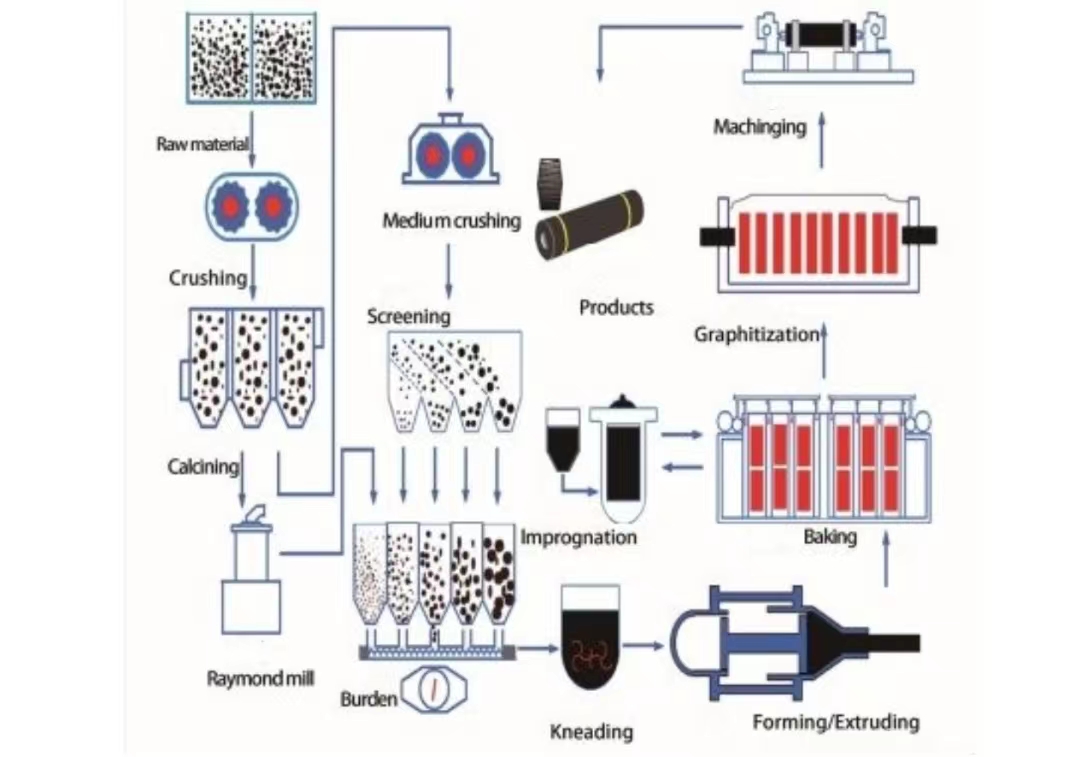Graphite electrodes, made from high-quality petroleum coke and needle coke, are a vital part of modern industry. But what exactly is it, and what is its role in various industrial processes?
目次
トグルIn this blog, we’ll delve into the uses and properties of graphite electrodes, providing a comprehensive overview of this essential component.
Understanding Graphite Electrodes
At its core, a 黒鉛電極 is a high-temperature resistant and highly conductive component used primarily in electric arc furnace (EAF) for steelmaking and other metallurgical and industrial applications. There are also ladle refining furnaces and submerged arc furnaces.
The superior thermal properties of graphite, its excellent electrical conductivity, and structural stability even at high temperatures make them indispensable.
The Role of Graphite Electrodes in EAF Steelmaking
Eaf steelmaking is one of the primary sectors where graphite electrodes come into play. Electric arc furnaces use them to melt scrap steel. The electrodes create an electric arc with an extremely high temperature of 3000°C that melts the scrap metal, allowing it to be recycled into new steel.
In this process, they serve as the conductive material, enabling a charge to pass through the furnace and generate the required heat. Their ability to withstand and operate efficiently at these high temperatures underpins their crucial role in EAF 製鋼.
Other Applications
Besides steelmaking, 黒鉛電極 find use in a variety of other industries:
Metal ore smelting: High-temperature resistant good conductor used in electric arc furnaces. When energized, an arc is generated and a large amount of heat is released for smelting.
Chemical industry:They are used in the production of chlorine and caustic soda by electrolysis of brine, as well as in fine chemical processes.
Semiconductor Industry: They are used in the smelting of basic materials such as monocrystalline silicon and polycrystalline silicon.
Energy industry: Used in the production of batteries, especially negative electrode materials for lithium batteries, to make full use of its high temperature resistance and conductive properties.
プロパティ
Electrical Conductivity: They are chosen for their superior electrical conductivity, allowing efficient electric current passage through the furnace.
Thermal Resistance: Withstanding high temperatures is vital in applications like EAFs. They provide excellent thermal resistance, maintaining their structure even under intense heat.
Mechanical Strength: Despite the high temperatures, it needs to maintain its structural integrity. The high mechanical strength of them ensures they do not break or deform under operational conditions.
Low Coefficient of Thermal Expansion: A low coefficient of thermal expansion means that the electrode doesn’t expand much when heated. This property prevents the electrode from cracking or breaking due to rapid temperature changes in the furnace.
製造工程
The manufacturing process of 黒鉛電極 is a multi-step procedure that starts with procuring raw materials, mainly petroleum and needle coke.
The materials are then pulverized and mixed with coal tar pitch as a binding agent. This mix is then molded into the shape of electrodes and baked at high temperatures.
Finally, they are graphitized by heating to a temperature above 3000°C and then machined to specific dimensions.
Impacts of Graphite Electrode Market Dynamics
It’s worth mentioning that the supply and demand dynamics of them significantly impact global industries. Since these electrodes are integral to EAF steel production, disruptions in their supply can hamper steel production rates.
On the other hand, an increase in steel production due to growing infrastructure projects can spike the demand and, subsequently, the price of graphite electrodes.
持続可能性
With the world increasingly focusing on sustainability, the role of graphite electrodes is becoming even more significant.
Electric arc furnace steelmaking is more environmentally friendly than traditional blast furnaces, as it allows scrap steel recycling.
Therefore, Their integral role in EAFs puts them at the heart of sustainable steelmaking.
Future Outlook
The future of graphite electrodes appears promising. With global industries shifting towards more energy-efficient practices, the demand for it is expected to rise.
Furthermore, advances in material science are likely to lead to the development of even more efficient and durable products.
In conclusion
Graphite electrodes are crucial in modern industry, from steelmaking to aluminum production. Their exceptional thermal resistance, excellent electrical conductivity, high mechanical strength, and low thermal expansion make them a key players in these demanding environments.
As we continue to see a rise in electric arc furnace steelmaking and environmentally conscious manufacturing processes, their use of them is set to grow. Thus, understanding their use and performance is vital for anyone involved in these industries.



